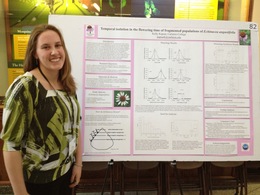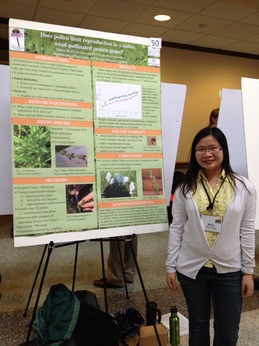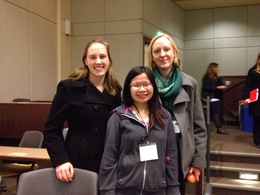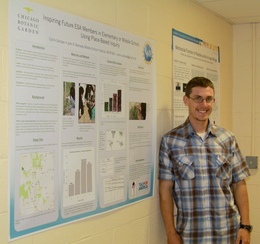|
|
Check out this episode of Prairie Yard & Garden. Stuart was interviewed this summer for this half-hour long public TV show about the Echinacea Project. The episode is called “Prairie Flora: History and Future” and it aired yesterday in western MN and the Dakotas.
Please help spread the word about prairies! Here’s the link: http://goo.gl/qU4bcN
The whole interview and much of the footage is from the main common garden experimental plot.
Hi everyone,
I presented a poster at MEEC 2013 (which Katherine wrote on in the previous entry) and just got back from another poster presentation at Chicago Area Undergraduate Research Symposium (CAURS) today!
Here’s my poster – enjoy looking at it to see what I found out from my summer fieldwork!
Wang_MEEC2013-Poster36x44-pdf.pdf
Greg Diersen gave an oral presentation “Pollinator Collecting for the Lab and Classroom” at the Life Discovery – Doing Science Inaugural Education Conference on Mar 15-16 in St. Paul, Minnesota.
As a science teacher participant in the Echinacea project through the National Science Foundation RET program, Greg developed a lesson plan for experimentally pan-trapping pollinators to use in secondary and post-secondary biology classes. This experiment offers diverse opportunities for doing science, learning biological concepts, and understanding about our changing world.
Greg was a high-school science teacher for 16 years and is now a professor of biology at Martin Luther College in New Ulm, MN. diersegtATmlc-wels.edu
This past weekend, three students associated with the Echinacea Project presented their work at the Midwest Ecology and Evolution Conference at Notre Dame.
Kelly Kapsar (Carleton College, 2014) spent the winter analyzing her data on flowering phenology in prairie remants and presented her results in a poster.

Maria Wang (Northwestern, 2013) presented the results of her undergraduate honors thesis on pollen limitation in the prairie grass Dicanthelium.

Master’s student Katherine Muller gave an oral presentation on her research on the relationship between Echinacea and its specialist aphid.

I should mention that Maria was recently accepted as a Master’s student in the Northwestern Program in Plant Biology and Conservation. She will graduate this summer and remain in Chicago another year to finish her M.S.. She will be working with Dr. Nyree Zerega investigating the genetic origins of tropical crops. Although we will miss her in the Echinacea Project, we wish her the best in her next endeavor.

Mindy Runge & Ale Mendoza participated in a mini-internship in the Echinacea lab at the Chicago Botanic Garden this fall. They are in Lynn Westley’s Plant Biology class at Lake Forest College.
Mindy & Ale investigated seed set in Echinacea heads from a prairie remnant in western Minnesota. They compared seed set in tops and bottoms of heads (florets at the bottom of a head flower first). In the process of answering their question, they learned how to dissect achenes from Echinacea seed heads, how to operate our high-tech seed balance, and how to organize datasets.

Ale and Mindy dissecting seedheads
Title: Inspiring future ESA members in elementary or middle school, using place-based inquiry
Abstract:
Many obstacles hold back students’ learning in science in K12 education. Some obstacles, such as school culture and persuasive paradigms that “school is not cool” are a few, long-term hindrances. Only about 1 in 3 middle school students currently achieve proficient scores on state tests. With great burdens and distressing statistics, what can teachers do? They can make short-term changes in pedagogy to increase motivation and responsibility in their students.
This project explored place-based inquiry, which allows students to use the natural environment in which they live as an inquiry-based learning environment. Students gained knowledge and learned skills that could apply across the curriculum. In a low-income middle school, in northwestern New Mexico, 160 students engaged in a mini-unit, broadly exploring the nature of life science. Students designed an observational study – they formulated questions, wrote procedures, collected data, and drew conclusions.
This type of pedagogy was successful for several reasons. First, students were motivated to answer questions that they typically could not answer with a textbook. Second, students gained knowledge and skills that could be used across the curriculum.
Here’s a pdf of the poster: ESA Poster cswitzer 12.pdf
The conference didn’t allow photos in the poster hall, so I took one later! Here’s me with my poster!
I’m really excited to present on Thursday at the U of M! Come check it out.PolEfficiency2012_small.pdf
Title: Examining Pollen Limitation in a native prairie panic grass, Dichanthelium leibergii
MW-UMN-30×40.pdf
It has lots of cool pictures and Dichanthelium as the background! 🙂
See you at the symposium!
Here’s the poster I will be presenting at the University of Minnesota on Thursday.
Shona Sanford-Long_compatibility poster_small.pdf
Here’s a copy of the poster that I submitted for the poster session at the University of Minnesota. It has some preliminary results as well as a list of future data analysis that I want to complete.
kapsar_UofMPoster.pdf
|
|






